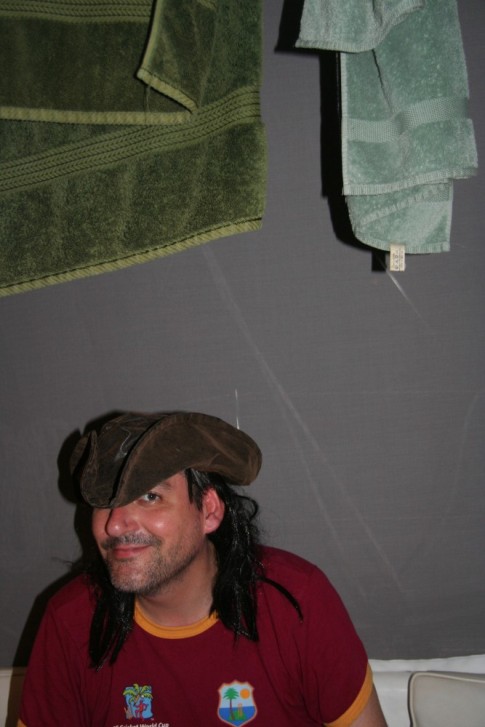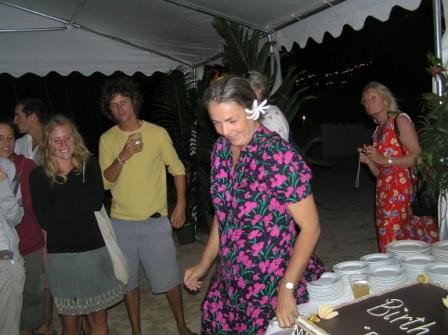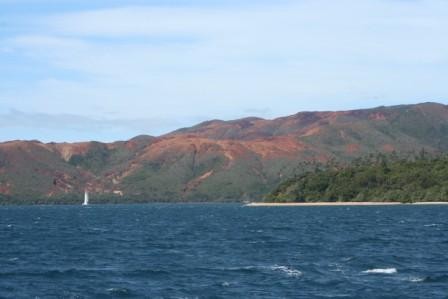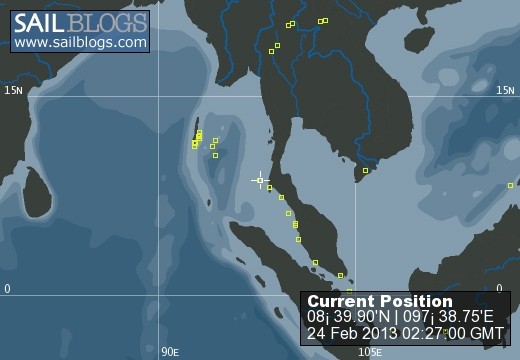
Around the World
23 February 2013 | Similan Islands Thailand
21 February 2013 | Bay of Bengal
15 February 2013 | Cinque Islands
15 February 2013 | Henry Lawrence Island
12 February 2013 | North Button Island
10 February 2013 | Henry Lawrence Island
09 February 2013 | Havelock Island
06 February 2013 | Neil Island
04 February 2013 | Rutland Island
01 February 2013 | Andaman Sea
30 January 2013 | Port Blair
26 January 2013 | Andaman Sea
26 January 2013 | Andaman Sea
03 December 2012 | Burma
02 December 2012
08 November 2012
08 November 2012 | Thailand
08 November 2012
10 June 2012 | Rebak Marina Langkawi
06 February 2012 | Malaysia
Birds nest soup - bonding with the orangutans
06 October 2011 | Kumai, Kumintan
michael and jackie
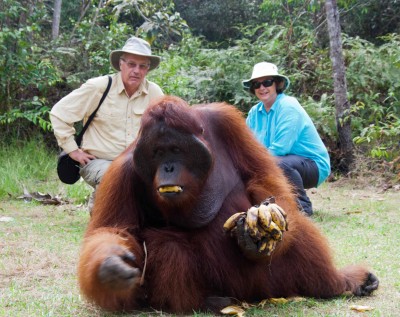
The long misty approach up the Kumai river eventually leads to an area where the river widens. Numerous ships are anchored in the shallow waters, mostly picking up palm oil. Along the river side there are large rectangular buildings which look like grain silos. Some have fake windows painted on them. Swallows fly in and out of them because these warehouses are in fact factories producing Birds Nests for the Chinese market (soup).

Kalimintan, the Southern edge of Borneo is an area of vast mineral resources. Vast areas of the jungle have been and are being burnt down and replaced with vast palm oil plantations for biofuel, beneath the palm trees vast deposits of coal have been discovered. The wealth has yet to percolate through to the ordinary people who still live a largely agrarian lifestyle.
We contacted Mr Bain, a local entrepreneur, owner of numerous chuk chuks, local wooden boats, painted blue with chukchuk diesel engines. Negotiations took place, a price agreed and the next morning we set off up river with our crew of guide, cook, skipper and "engineer?".

The ancient engine struggled and our engineer had to take frequent dives in his underwear to check the propeller which curiously seemed to also involve discharges of oil but the "African Queen" kept going despite all.

We were in fact treated like royalty on the trip up river, water, tea and fruit on tap all the time along with massive well cooked meals and snacks. Not a trip to lose weight on. At night we slept on the top deck of the boat under a massive mosquito net, listening to the sometimes slightly worrying sounds of the jungle.
The national park is on the South side of the river as you go up. At first palm trees line the route with glimpses of cultivated land on the North side contrasting with the more jungle like North. The occasional fisherman in a wooden canoe can be spotted along with the remains of old boats. Occasional fast motor boats shoot by carrying we were told illegal miners and their families.

Along the river bank we noticed shreds of palm leaves - signs of orangutans - and then trees moving. Our first sighting - orangutans in the wild - in the trees and gathering palm leaves by the river side - doing incredible leaps through the trees. We had never really realised before how athletic they are and how high in the tree tops the Orangutans move.

After about four hours we turned right up what the crew called the black river into the national park area. The river here is dark black with tannin from the rotting trees and vegetation which means that you get startling reflections. The dark river also helps conceal the many crocodiles and contrasts with amazing kingfishers who look like something out of a comic book with their startling blue bodies set off with bright yellow and red heads- large birds that move off fast and whom we kept missing for photos. Hornbills soared overhead - unmmistakeable with the light catching their massive white bills. Troupes of proboscis monkeys sat on guard in the high branches of the trees looking a bit like strange old men.

Eventually in mid afternoon we arrived at the Leakey centre. This is a centre for the rehabilitation of captured orangutans, and the study of them in their wild habitat. Orangutans abound in this area. Since there is insufficient natural habitat there are regular feedings of orangutans here and at three other stations in the jungle. Orangutans. Monkeys crash through the trees - hang in the trees waiting their turn.


Where the dominant male is present he takes the food first - might being right.

Our guide, Dodi, was a real fan of the jungle. He knew many of the orangutans by their name and their family history, and was able to call them down from the trees in some cases for a generous reward. He also had an amazing repertoire of bird calls to attract birds and other animals.
Orangutans appeared to say hello, to show off, in some cases they try to charm food out of the visitor, in contrast to the fully independent ones we saw from the river.

it's not until you see them in the wild that you really appreciate the remarkable dexterity of these animals as they move through the trees using branches to catapult themselves from one tree to the other - their young clinging on to them. We had also not realised how often the branches break, but despite the occasional fall, the Orangutangs just tear off the broken branches and manage to catch hold elsewhere. They nurture their young for a full 8 years before they become independent.

We visited three different feeding stations in the jungle - each with their own residents and each with a different feel to it depending on the habitat and the balance of male to female.

After two days we were exhausted but exhiliarated.
Truly a remarkable experience

Kalimintan, the Southern edge of Borneo is an area of vast mineral resources. Vast areas of the jungle have been and are being burnt down and replaced with vast palm oil plantations for biofuel, beneath the palm trees vast deposits of coal have been discovered. The wealth has yet to percolate through to the ordinary people who still live a largely agrarian lifestyle.
We contacted Mr Bain, a local entrepreneur, owner of numerous chuk chuks, local wooden boats, painted blue with chukchuk diesel engines. Negotiations took place, a price agreed and the next morning we set off up river with our crew of guide, cook, skipper and "engineer?".

The ancient engine struggled and our engineer had to take frequent dives in his underwear to check the propeller which curiously seemed to also involve discharges of oil but the "African Queen" kept going despite all.

We were in fact treated like royalty on the trip up river, water, tea and fruit on tap all the time along with massive well cooked meals and snacks. Not a trip to lose weight on. At night we slept on the top deck of the boat under a massive mosquito net, listening to the sometimes slightly worrying sounds of the jungle.

The national park is on the South side of the river as you go up. At first palm trees line the route with glimpses of cultivated land on the North side contrasting with the more jungle like North. The occasional fisherman in a wooden canoe can be spotted along with the remains of old boats. Occasional fast motor boats shoot by carrying we were told illegal miners and their families.

Along the river bank we noticed shreds of palm leaves - signs of orangutans - and then trees moving. Our first sighting - orangutans in the wild - in the trees and gathering palm leaves by the river side - doing incredible leaps through the trees. We had never really realised before how athletic they are and how high in the tree tops the Orangutans move.

After about four hours we turned right up what the crew called the black river into the national park area. The river here is dark black with tannin from the rotting trees and vegetation which means that you get startling reflections. The dark river also helps conceal the many crocodiles and contrasts with amazing kingfishers who look like something out of a comic book with their startling blue bodies set off with bright yellow and red heads- large birds that move off fast and whom we kept missing for photos. Hornbills soared overhead - unmmistakeable with the light catching their massive white bills. Troupes of proboscis monkeys sat on guard in the high branches of the trees looking a bit like strange old men.

Eventually in mid afternoon we arrived at the Leakey centre. This is a centre for the rehabilitation of captured orangutans, and the study of them in their wild habitat. Orangutans abound in this area. Since there is insufficient natural habitat there are regular feedings of orangutans here and at three other stations in the jungle. Orangutans. Monkeys crash through the trees - hang in the trees waiting their turn.


Where the dominant male is present he takes the food first - might being right.

Our guide, Dodi, was a real fan of the jungle. He knew many of the orangutans by their name and their family history, and was able to call them down from the trees in some cases for a generous reward. He also had an amazing repertoire of bird calls to attract birds and other animals.
Orangutans appeared to say hello, to show off, in some cases they try to charm food out of the visitor, in contrast to the fully independent ones we saw from the river.

it's not until you see them in the wild that you really appreciate the remarkable dexterity of these animals as they move through the trees using branches to catapult themselves from one tree to the other - their young clinging on to them. We had also not realised how often the branches break, but despite the occasional fall, the Orangutangs just tear off the broken branches and manage to catch hold elsewhere. They nurture their young for a full 8 years before they become independent.

We visited three different feeding stations in the jungle - each with their own residents and each with a different feel to it depending on the habitat and the balance of male to female.

After two days we were exhausted but exhiliarated.
Truly a remarkable experience
Comments
| Vessel Name: | Lady Kay |
| Vessel Make/Model: | Lagoon 380 |
| Hailing Port: | Falmouth |
| Crew: | Michael & Jackie Chapman |
Blue Waters
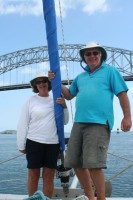
Who: Michael & Jackie Chapman
Port: Falmouth

